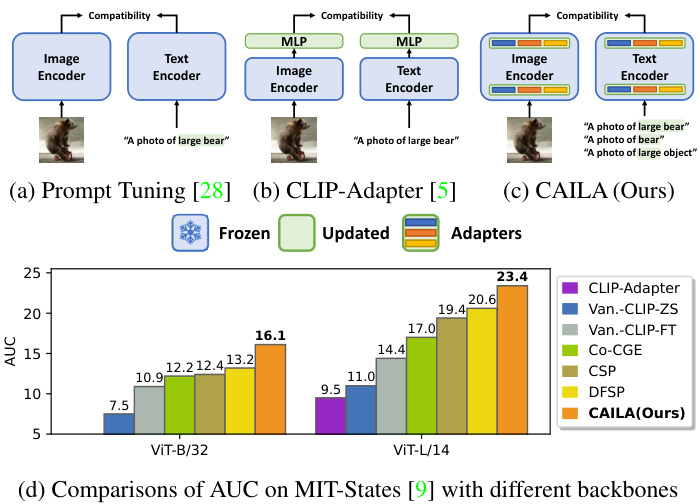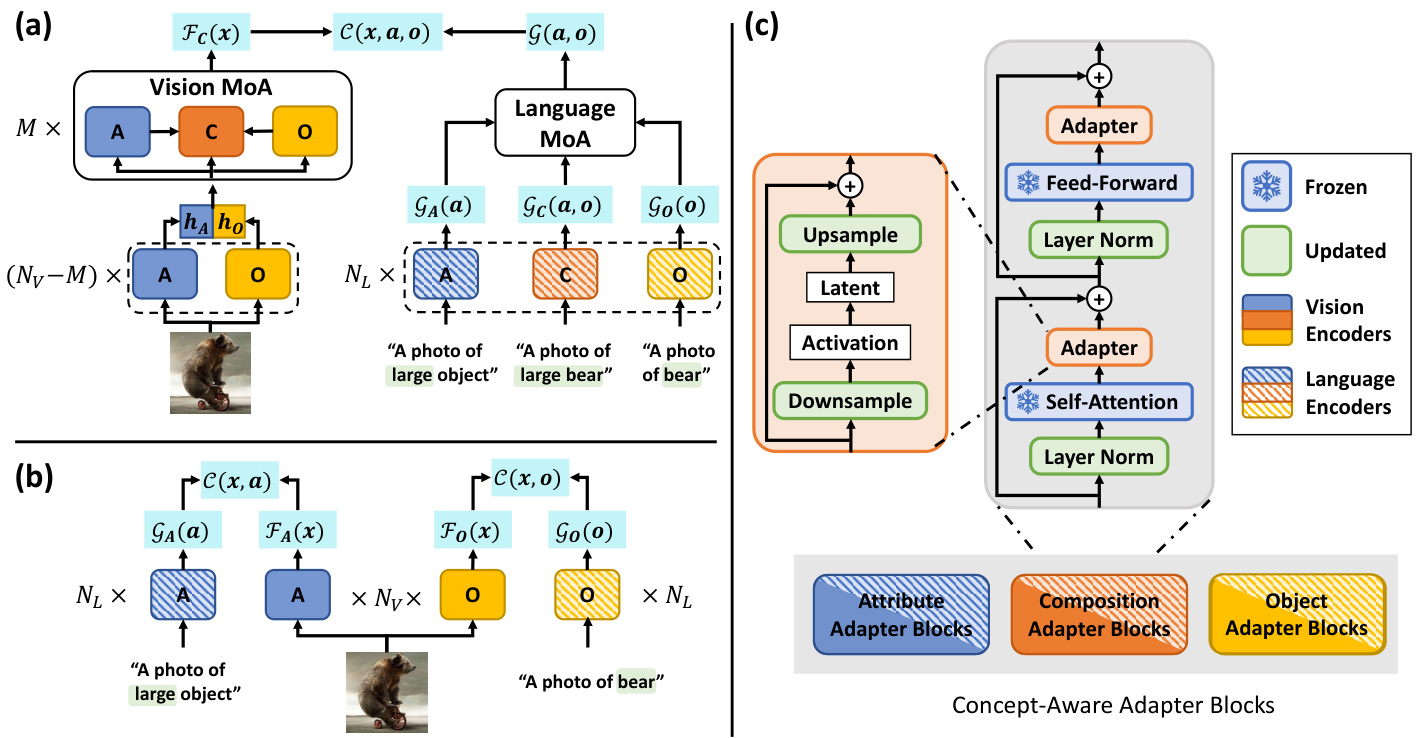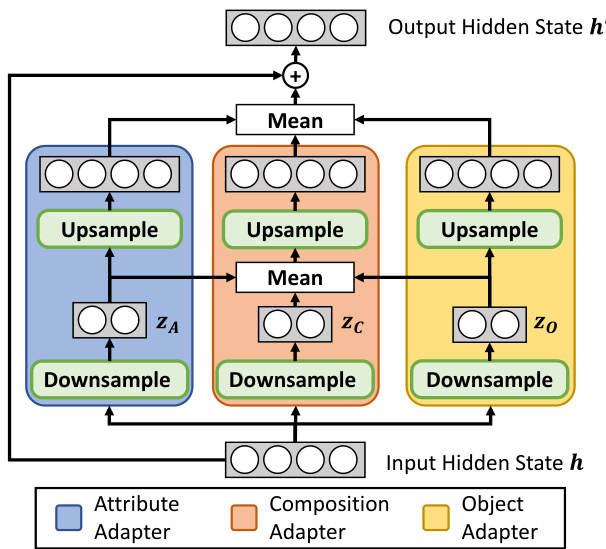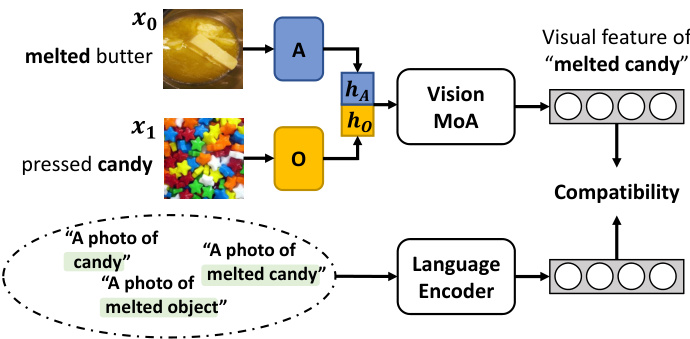CAILA: Concept-Aware Intra-Layer Adapters for Compositional Zero-Shot Learning
CAILA: 面向组合零样本学习的概念感知层内适配器
Abstract
摘要
In this paper, we study the problem of Compositional Zero-Shot Learning (CZSL), which is to recognize novel attribute-object combinations with pre-existing concepts. Recent researchers focus on applying large-scale VisionLanguage Pre-trained (VLP) models like CLIP with strong generalization ability. However, these methods treat the pre-trained model as a black box and focus on pre- and post-CLIP operations, which do not inherently mine the semantic concept between the layers inside CLIP. We propose to dive deep into the architecture and insert adapters, a parameter-efficient technique proven to be effective among large language models, into each CLIP encoder layer. We further equip adapters with concept awareness so that concept-specific features of “object”, “attribute”, and “composition” can be extracted. We assess our method on four popular CZSL datasets, MIT-States, C-GQA, UTZappos, and VAW-CZSL, which shows state-of-the-art performance compared to existing methods on all of them.
本文研究了组合零样本学习 (Compositional Zero-Shot Learning, CZSL) 问题,即利用已有概念识别新的属性-对象组合。近期研究侧重于应用具有强泛化能力的大规模视觉语言预训练 (Vision-Language Pre-trained, VLP) 模型(如 CLIP)。然而,这些方法将预训练模型视为黑箱,主要关注 CLIP 模型的前后处理操作,并未深入挖掘 CLIP 内部各层间的语义概念关联。我们提出深入模型架构,在 CLIP 的每个编码器层中插入适配器 (adapter)——一种在大语言模型中被验证有效的参数高效技术。我们进一步为适配器赋予概念感知能力,从而提取"对象"、"属性"和"组合"等特定概念的特征。该方法在四个主流 CZSL 数据集(MIT-States、C-GQA、UTZappos 和 VAW-CZSL)上进行了评估,结果显示其性能在所有数据集上均优于现有方法。

Figure 1. Illustrations of CAILA and previous CLIP-based baselines. CAILA has adapters integrated into both CLIP encoders and thus better transfers the knowledge from CLIP to CZSL, resulting in significant performance boosts compared with other CLIP-based baseline methods. “Van.-CLIP” refers to models with vanilla CLIP architecture. Prompts highlighted in green are set to be learnable parameters.
图 1: CAILA与现有基于CLIP的基线方法对比示意图。CAILA在CLIP双编码器中集成了适配器模块,能更高效地将CLIP知识迁移至CZSL任务,相比其他基于CLIP的基线方法实现了显著性能提升。"Van.-CLIP"指采用原始CLIP架构的模型。绿色高亮的提示词设为可学习参数。
1. Introduction
1. 引言
When facing a novel concept such as a large castle, humans can deconstruct individual components (large and castle) from familiar concepts (large bear, old castle) to comprehend the new composition. Such task of recognizing new attribute-object compositions based on a set of observed pairs is Compositional Zero-Shot Learning (CZSL) [24], a sine qua non for an intelligent entity. However, the inherent challenge in CZSL lies in the capacity to identify unobserved novel compositions without compromising the recognition of previously observed combinations. Conventional approaches [1, 19, 20, 23–27, 31, 35, 39, 40, 43] often suffer from training biases. Even though recent methods employ large-scale Vision-Language Pre-training (VLP)
面对诸如"大型城堡"这样的新概念时,人类能够从熟悉的概念(大型熊、古老城堡)中解构出单个要素(大型、城堡)来理解新的组合。这种基于一组已观察到的属性-对象对来识别新组合的任务被称为组合零样本学习 (CZSL) [24],是智能实体的必备能力。然而,CZSL的内在挑战在于识别未观测到的新组合时,不能损害对已观测组合的识别能力。传统方法 [1, 19, 20, 23–27, 31, 35, 39, 40, 43] 往往受困于训练偏差。尽管近期方法采用了大规规模视觉语言预训练 (VLP)
models with strong generalization ability, e.g., CLIP [32], to accommodate this issue, they simply treat VLP models as frozen black box encoders and fail to exploit the potential of VLP models. Thus, here, we explore how to more effectively extract and utilize the knowledge embedded in pre-trained vision-language models for the recognition of novel attribute-object compositions.
具有强大泛化能力的模型(如CLIP [32])来解决这一问题,他们仅将视觉语言预训练(VLP)模型视为冻结的黑盒编码器,未能充分挖掘其潜力。因此,我们在此探索如何更有效地提取和利用预训练视觉语言模型中嵌入的知识,以识别新颖的属性-对象组合。
More specifically, to adapt VLP models for CZSL, some researchers apply prompt-tuning [28,47,48] or fine-tune the model with extra adaptation layers [5] on the top of CLIP. However, prompt-tuning methods, depicted in Figure 1(a), only learn trainable prompts, while CLIP-Adapter, shown in Figure 1(b), only adds external modules outside CLIP. Both strategies abstain from altering the fundamental CLIP encoder, consequently retaining CLIP as a static black box. Nayak et al. [28] have shown that exhaustively fine-tuning CLIP falls short of attaining practicable performance. Thus, we argue that properly optimizing features across layers through a task-specific design is critical to effectively harnessing the knowledge embedded in CLIP. A feasible CLIPbased CZSL should: i) have task-specific designs for CZSL; ii) be capable of extracting concept-specific features related to compositions and individual primitives.
具体来说,为了让视觉语言预训练 (VLP) 模型适应组合零样本学习 (CZSL),一些研究者在 CLIP 基础上采用提示调优 [28,47,48] 或通过额外适配层微调模型 [5]。然而,如图 1(a) 所示的提示调优方法仅学习可训练提示词,而图 1(b) 所示的 CLIP-Adapter 仅在 CLIP 外部添加模块。这两种策略都避免改动 CLIP 编码器核心结构,导致 CLIP 始终作为静态黑箱运行。Nayak 等人 [28] 已证明,对 CLIP 进行全参数微调难以达到实用性能。因此我们认为,通过任务定制化设计对各层特征进行合理优化,对有效利用 CLIP 内嵌知识至关重要。一个可行的基于 CLIP 的 CZSL 方案应满足:i) 具有针对 CZSL 的任务定制设计;ii) 能提取与组合体及其组成元素相关的概念特异性特征。
Hence, we propose CAILA , Concept-Aware IntraLayer Adapters, that satisfy the given prerequisites and substantiate its superiority, as shown in Fig. 1(d), compared with other CLIP-based methods. Fig. 1(c) highlights the difference between CAILA and other VLP-based methods. Instead of prompt tuning or fully fine-tuning, we adopt adapters [7] to transfer knowledge from VLP models while avoiding strong training biases.
因此,我们提出CAILA(概念感知层内适配器),它满足给定的前提条件,并证实了其优越性,如图1(d)所示,与其他基于CLIP的方法相比。图1(c)突出了CAILA与其他基于视觉语言预训练(VLP)方法的区别。我们采用适配器[7]来迁移VLP模型的知识,而非提示调优或完全微调,从而避免强烈的训练偏差。
Moreover, given that adapters are low-overhead components, it is feasible to employ a variety of adapters to extract concept-wise representations. More specifically, CAILA integrates a group of adapters into each layer of both encoders; each group possesses concept-specific components to extract knowledge corresponding to particular concepts, including attributes, objects, and compositions. To merge features extracted by various concept-aware adapters, we propose the Mixture-of-Adapters (MoA) mechanism for both vision and yrcy encoder. In addition, the property that CAILA can extract concept-specific features allows us to further propose Primitive Concept Shift, which generates additional vision embeddings by combining the attribute feature from one image and the object feature from another for a more comprehensive understanding.
此外,考虑到适配器是低开销组件,采用多种适配器提取概念级表征是可行的。具体而言,CAILA在双编码器的每一层都集成了一组适配器,每组包含针对特定概念(如属性、对象及组合)的专用组件以提取相应知识。为融合不同概念感知适配器提取的特征,我们为视觉和yrcy编码器提出了混合适配器(Mixture-of-Adapters,MoA)机制。此外,CAILA能提取概念特异性特征的性质,使我们进一步提出原始概念迁移(Primitive Concept Shift),该方法通过组合一张图像的属性特征与另一张图像的对象特征来生成额外的视觉嵌入,以实现更全面的理解。
We evaluate our approach on three popular CZSL datasets: MIT-States [9], C-GQA [25] and UT-Zappos [44, 45], under both closed world and open world settings. We also report the performance of CAILA in closed world on VAW-CZSL [35], a newly released benchmark. Our experiments show that, in both scenarios, our model beats the state-of-the-arts over all benchmarks following the generalized evaluation protocol [31], by significant margins.
我们在三个流行的组合零样本学习(CZSL)数据集上评估了我们的方法:MIT-States [9]、C-GQA [25] 和 UT-Zappos [44,45],涵盖封闭世界和开放世界两种设定。同时,我们在新发布的VAW-CZSL [35]基准测试中报告了CAILA在封闭世界下的性能。实验表明,在广义评估协议[31]框架下,我们的模型在所有基准测试中都显著超越了当前最优方法。
To summarize, our contributions are as follows: (i) We propose CAILA, which is the first model exploring CZSLoriented designs with CLIP models to balance model capacity and training bias robustness; (ii) we design the Mixtureof-Adapter (MoA) mechanism to fuse the knowledge from concept-aware adapters and improve the general iz ability; (iii) we further enrich the training data and exploit the power of CAILA through Primitive Concept Shifts; (iv) we conduct extensive experiments in exploring the optimal setup for CAILA on CZSL. Quantitative experiments show that our model outperforms the SOTA by significant margins in both closed world and open world, on all benchmarks.
总结来说,我们的贡献如下:(i) 我们提出了CAILA,这是首个探索面向CZSL(组合零样本学习)设计并与CLIP模型结合以平衡模型容量和训练偏差鲁棒性的模型;(ii) 我们设计了混合适配器(Mixture-of-Adapter,MoA)机制,用于融合概念感知适配器的知识并提升泛化能力;(iii) 我们通过原始概念迁移(Primitive Concept Shifts)进一步丰富了训练数据并充分发挥了CAILA的潜力;(iv) 我们在CZSL上进行了大量实验以探索CAILA的最佳配置。定量实验表明,我们的模型在闭集和开集场景下的所有基准测试中均显著优于当前最优方法(SOTA)。
2. Related Works
2. 相关工作
Zero-Shot Learning (ZSL). Unlike conventional fullysupervised learning, ZSL requires models to learn from side information without observing any visual training samples [16]. The side information comes from multiple non-visual resources such as attributes [16], word embeddings [36, 38] , and text descriptions [33]. Notably, Zhang et al. [46] propose to learn a deep embedding model bridging the seen and the unseen, while [2,42,49] investigate generative models that produce features for novel categories. Moreover, [11, 38] integrate Graph Convolution Networks (GCN) [15] to better generalize over unseen categories.
零样本学习 (ZSL) 。与传统全监督学习不同,零样本学习要求模型在不观察任何视觉训练样本的情况下从辅助信息中学习 [16] 。这些辅助信息来自多种非视觉资源,例如属性 [16] 、词嵌入 [36, 38] 和文本描述 [33] 。值得注意的是,Zhang 等人 [46] 提出学习一个深度嵌入模型来连接已知和未知类别,而 [2,42,49] 则研究了为新颖类别生成特征的生成式模型。此外,[11, 38] 整合了图卷积网络 (GCN) [15] 以更好地泛化到未见类别。
Compost ional Zero-Shot Learning (CZSL). Previous CZSL approaches are built with pre-trained image encoders, e.g. ResNet and separate word embeddings, e.g. GloVe [30]. More specifically, Li et al. [20] investigate the symmetrical property between objects and attributes, while Atzmon et al. [1] study the casual influence between the two. Moreover, Li et al. [19] construct a Siamese network with contrastive learning to learn better object/attribute prototypes. On the other hand, joint representations of compositions can be leveraged in multiple ways. [31] utilizes joint embeddings to control gating functions for the modular network, while [26, 27, 40, 43] treat them as categorical centers in the joint latent space. Furthermore, some approaches [23–25,34,39] directly take compositional embeddings as classifier weights, while OADis [35] disentangles attributes and objects in the visual space.
组合式零样本学习 (CZSL)。现有的CZSL方法通常采用预训练图像编码器(如ResNet)和独立词嵌入(如GloVe [30])构建。具体而言,Li等人[20]研究了物体与属性间的对称性关系,Atzmon等人[1]则探讨了两者间的因果影响。此外,Li等人[19]通过构建对比学习的连体网络来优化物体/属性原型学习。另一方面,组合表征可通过多种方式加以利用:[31]采用联合嵌入控制模块化网络的门控函数,而[26,27,40,43]将其视为联合潜在空间中的分类中心。另有方法[23-25,34,39]直接将组合嵌入作为分类器权重,OADis[35]则实现了视觉空间中属性与物体的解耦。
Parameter-Efficient Tuning. Recent research on large scale pre-training models [6, 8, 10, 18, 32] has achieved superior performance on various downstream tasks, compared with regular approaches. Various works [7,12,37] show that tuning adapters [7] on the language side yields comparable results with fully fine-tuned variants, while Chen et al. [3] investigate the adaptation of image encoders on dense prediction tasks. For CZSL, a few models [28, 48] leverage the knowledge of CLIP through prompt tuning [17] , while Gao et al. [5] attach a post-processor to CLIP for knowledge transfer. Though these methods show strong performance on CZSL against regular models, they treat the CLIP model as a black box and keep it completely frozen. In CAILA , we open up the CLIP black box by integrating intra-layer adapters to both image and text encoders.
参数高效调优。近期关于大规模预训练模型[6,8,10,18,32]的研究表明,相比常规方法,这些模型在各种下游任务中表现更优。多项工作[7,12,37]指出,仅对语言侧适配器(adapter)[7]进行调优即可获得与全参数微调相当的效果,而Chen等人[3]则研究了图像编码器在密集预测任务中的适配方法。在CZSL领域,部分模型[28,48]通过提示调优(prompt tuning)[17]利用CLIP的知识,Gao等人[5]则为CLIP添加后处理器实现知识迁移。尽管这些方法在CZSL任务中展现出优于常规模型的性能,但它们都将CLIP视为黑箱并保持完全冻结状态。在CAILA中,我们通过向图像和文本编码器集成层内适配器,打开了CLIP的黑箱结构。
3. Approach
3. 方法
The problem of CZSL can be formulated as follows. We denote the training set by $\mathcal T={(x,y)|x\in\mathcal X,y\in\mathcal V_{s}}$ , where $\mathcal{X}$ contains images represented in the RGB color space and $\mathcal{D}{s}$ is a set of seen composition labels which are available during the training phase. Each label $y=(a,o)$ is a pair of attribute $a\in A$ and object category $o\in\mathcal{O}$ . When testing, CZSL expects models to predict a set of unseen compositions ${\mathcal{V}}{u}$ that is mutually exclusive with training labels $\mathcal{D}{s}$ : $\mathcal{V}{s}\cup\mathcal{V}{u}=\emptyset$ . Note that $\mathcal{D}{s}$ and ${\mathcal{V}}{u}$ share the same set of $A,{\mathcal{O}}$ , while CZSL assumes that each $a\in{\mathcal{A}}$ or $o\in\mathcal{O}$ exists in the training set and only the composition $(a,o)\in\mathcal{Y}{u}$ is novel. Following [25, 31, 41], we focus on generalized CZSL, where the test set contains both seen and unseen labels, formally denoted by $\mathcal{V}{t e s t}=\mathcal{V}{s}\cup\mathcal{V}_{u}$ .
CZSL问题可以表述如下。我们将训练集表示为$\mathcal T={(x,y)|x\in\mathcal X,y\in\mathcal V_{s}}$,其中$\mathcal{X}$包含RGB色彩空间表示的图像,$\mathcal{D}{s}$是训练阶段可见的组合标签集合。每个标签$y=(a,o)$由属性$a\in A$和物体类别$o\in\mathcal{O}$组成。测试时,CZSL要求模型预测与训练标签$\mathcal{D}{s}$互斥的未见组合集合${\mathcal{V}}{u}$:$\mathcal{V}{s}\cup\mathcal{V}{u}=\emptyset$。需注意$\mathcal{D}{s}$和${\mathcal{V}}{u}$共享相同的$A,{\mathcal{O}}$集合,且CZSL假设每个$a\in{\mathcal{A}}$或$o\in\mathcal{O}$在训练集中存在,仅组合$(a,o)\in\mathcal{Y}{u}$是新颖的。根据[25,31,41],我们关注广义CZSL场景,其测试集同时包含可见与未见标签,形式化表示为$\mathcal{V}{t e s t}=\mathcal{V}{s}\cup\mathcal{V}_{u}$。
Most recent works [1,25,31] study the generalized CZSL problem under the closed world setting, where $\mathcal{D}{t e s t}$ is a subset of the complete composition set $y:{\mathcal{A}}\times{\mathcal{O}}$ . The closed world setting assumes that ${\mathcal{V}}{u}$ are known during testing and thus greatly reduce the size of the search space. On the contrary, Mancini et al. [22] argue that such constraint should not be applied to the search space and introduce the open world setting, where models are required to search over the complete set of compositions, formally $\mathcal{Y}{s}\cup\mathcal{Y}_{u}=\mathcal{Y}$ . In this paper, we investigate the problem in both closed world and open world.
大多数最新研究[1,25,31]都在封闭世界设定下研究广义CZSL问题,其中$\mathcal{D}{t e s t}$是完整组合集$y:{\mathcal{A}}\times{\mathcal{O}}$的子集。封闭世界设定假设测试期间已知${\mathcal{V}}{u}$,从而大幅缩小了搜索空间。相反,Mancini等人[22]认为这种限制不应施加于搜索空间,并提出了开放世界设定,要求模型在整个组合集上进行搜索,即$\mathcal{Y}{s}\cup\mathcal{Y}_{u}=\mathcal{Y}$。本文将在封闭世界和开放世界两种设定下研究该问题。
3.1. Compatibility Estimation Pipeline
3.1. 兼容性评估流程
As different attributes can lead to significant appearance shifts even inside the same object category, performing attribute and object predictions separately may be ineffective. Hence, we model attribute-object compositions jointly and learn a combined estimation function to measure the compatibility of input image $x$ and query composition $(a,o)$ . In addition, we let the model estimate attribute and object comp a tibi li ties as auxiliary sub-tasks during training.
由于同一物体类别内不同属性可能导致显著的外观变化,单独预测属性和物体可能效果不佳。因此,我们联合建模属性-物体组合,并学习一个联合估计函数来衡量输入图像$x$与查询组合$(a,o)$的兼容性。此外,我们让模型在训练过程中将属性和物体兼容性估计作为辅助子任务。
The estimation of composition compatibility is represented as $\mathcal{C}(\boldsymbol{x},\boldsymbol{a},\boldsymbol{o}):\boldsymbol{\mathcal{X}}\times\boldsymbol{\mathcal{A}}\times\boldsymbol{\mathcal{O}}\rightarrow\mathbb{R}$ . It contains two components: The image feature extractor $\mathcal{F}{C}:\mathbb{R}^{H\times W\times3}\rightarrow\mathbb{R}^{d}$ and the text embedding generator $\mathcal{G}:\mathcal{A}\times\mathcal{O}\rightarrow\mathbb{R}^{d}$ . Note that $d$ denotes the number of channels that each representation has. Given an image $x$ and a composition $(a,o)$ , the compatibility score is defined as the dot product of $\mathcal{F}_{C}(\boldsymbol{x})$ and $\mathcal{G}(a,o)$ , formally
组合兼容性估计表示为 $\mathcal{C}(\boldsymbol{x},\boldsymbol{a},\boldsymbol{o}):\boldsymbol{\mathcal{X}}\times\boldsymbol{\mathcal{A}}\times\boldsymbol{\mathcal{O}}\rightarrow\mathbb{R}$。它包含两个组件:图像特征提取器 $\mathcal{F}{C}:\mathbb{R}^{H\times W\times3}\rightarrow\mathbb{R}^{d}$ 和文本嵌入生成器 $\mathcal{G}:\mathcal{A}\times\mathcal{O}\rightarrow\mathbb{R}^{d}$。注意 $d$ 表示每个表征的通道数。给定图像 $x$ 和组合 $(a,o)$,兼容性得分定义为 $\mathcal{F}_{C}(\boldsymbol{x})$ 与 $\mathcal{G}(a,o)$ 的点积,形式化表示为
$$
\begin{array}{r}{\mathcal{C}(\boldsymbol{x},\boldsymbol{a},\boldsymbol{o})=\mathcal{F}_{C}(\boldsymbol{x})\cdot\mathcal{G}(\boldsymbol{a},\boldsymbol{o}).}\end{array}
$$
$$
\begin{array}{r}{\mathcal{C}(\boldsymbol{x},\boldsymbol{a},\boldsymbol{o})=\mathcal{F}_{C}(\boldsymbol{x})\cdot\mathcal{G}(\boldsymbol{a},\boldsymbol{o}).}\end{array}
$$
Furthermore, as CZSL requires models to recognize novel pairs composed of known attributes and objects, it is important for a model to possess the capability of primitive feature extraction that is disentangled with training compositions. Thus, we make our model extract features corresponding to primitives and estimate the compatibility between vision features and text representations during training. Similar to Eqn. 1, we have
此外,由于CZSL要求模型识别由已知属性和对象组成的新颖组合,模型必须具备与训练组合解耦的基元特征提取能力。因此,我们让模型在训练过程中提取与基元对应的特征,并评估视觉特征与文本表征之间的兼容性。类似于公式1,我们有
$$
{\mathcal{C}}(x,a)={\mathcal{F}}{A}(x)\cdot{\mathcal{G}}{A}(a),{\mathcal{C}}(x,o)={\mathcal{F}}{O}(x)\cdot{\mathcal{G}}_{O}(o).
$$
$$
{\mathcal{C}}(x,a)={\mathcal{F}}{A}(x)\cdot{\mathcal{G}}{A}(a),{\mathcal{C}}(x,o)={\mathcal{F}}{O}(x)\cdot{\mathcal{G}}_{O}(o).
$$
All three compatibility scores contribute independently to the loss function, while $\mathcal{C}(\boldsymbol{x},\boldsymbol{a},o)$ is leveraged during inference. More specifically, our framework learns separate representations through CAILA discussed in Sec. 3.2 and conducts knowledge fusion through Mixture-of-Adapters (MoA), which will be covered in Sec. 3.3.
三个兼容性分数独立贡献于损失函数,而推理过程中会利用 $\mathcal{C}(\boldsymbol{x},\boldsymbol{a},o)$。具体而言,我们的框架通过第3.2节讨论的CAILA学习独立表征,并通过第3.3节将介绍的混合适配器 (Mixture-of-Adapters, MoA) 进行知识融合。
Following [32], we create a prompt template similar to $"a$ photo of [CLASS]" for each compatibility estimation sub-task. For composition compatibility, we feed the text encoder with "a photo of [ATTRIBUTE] [OBJECT]"; We use "a photo of [ATTRIBUTE] object" and $"a$ photo of [OBJECT]" for attribute and object comp a tibi li ties, respectively. Similar to [28], we only make [CLASS] prompts trainable. For both encoders $\mathcal{F}$ and $\mathcal{G}$ , we take the output hidden state of the [CLS] token as the representation.
遵循[32]的方法,我们为每个兼容性评估子任务创建了类似 $"a$ photo of [CLASS]" 的提示模板。对于组合兼容性,我们将"a photo of [ATTRIBUTE] [OBJECT]"输入文本编码器;分别使用"a photo of [ATTRIBUTE] object"和 $"a$ photo of [OBJECT]"来评估属性和对象兼容性。与[28]类似,我们仅使[CLASS]提示可训练。对于编码器 $\mathcal{F}$ 和 $\mathcal{G}$,我们取[CLS] token的输出隐藏状态作为表征。
3.2. Concept-Aware Intra-Layer Adapters
3.2. 概念感知层内适配器
Though CLIP-based CZSL approaches [5, 28, 48] have achieved significant improvements compared with earlier methods [22, 24, 25, 28, 31], the CLIP encoder is considered as a black box and no modifications are made to improve its general iz ability. Thus, we propose to improve CLIP-based CZSL models in both modalities with CAILA , ConceptAware Intra-Layer Adapters.
尽管基于CLIP的CZSL方法[5, 28, 48]相比早期方法[22, 24, 25, 28, 31]取得了显著改进,但CLIP编码器被视为黑箱且未进行改进以提升其泛化能力。为此,我们提出通过CAILA (ConceptAware Intra-Layer Adapters) 在双模态中改进基于CLIP的CZSL模型。
As shown in Fig. 2 (a)(b), we take the CLIP image encoder as $\mathcal{F}$ and the text encoder as $\mathcal{G}$ , while adding concept awareness to both encoders when estimating comp a tibi li ties of different concepts. Fig. 2 (c) demonstrates how adapters are integrated into a regular transformer encoding block. For each encoding block, we add adapters behind the frozen self-attention layer and the feed-forward network. More specifically, given the input hidden state h of an adapter, we compute the latent feature $\mathbf{z}$ by the down sampling operator $f_{D o w n}$ , followed by the activation function $\sigma$ . The output $\mathbf{h}^{\prime}$ of an adapter is obtained by upscaling $\mathbf{z}$ and summing it with $\mathbf{h}$ through the skip connection. Formally, we have
如图 2(a)(b)所示, 我们将 CLIP 图像编码器作为 $\mathcal{F}$, 文本编码器作为 $\mathcal{G}$, 同时在估计不同概念的兼容性时为两个编码器添加概念感知能力。图 2(c)展示了适配器如何集成到常规的 Transformer 编码块中。对于每个编码块, 我们在冻结的自注意力层和前馈网络之后添加适配器。具体来说, 给定适配器的输入隐藏状态 h, 我们通过下采样算子 $f_{Down}$ 计算潜在特征 $\mathbf{z}$, 然后经过激活函数 $\sigma$。适配器的输出 $\mathbf{h}^{\prime}$ 是通过对 $\mathbf{z}$ 进行上采样并通过跳跃连接与 $\mathbf{h}$ 相加得到的。形式上, 我们有
$$
\mathbf{z}=\sigma(f_{D o w n}(\mathbf{h})),\quad\mathbf{h}^{\prime}=f_{U p}(\mathbf{z})+\mathbf{h},
$$
$$
\mathbf{z}=\sigma(f_{D o w n}(\mathbf{h})),\quad\mathbf{h}^{\prime}=f_{U p}(\mathbf{z})+\mathbf{h},
$$
where both $f_{D o w n}$ and $f_{U p}$ are fully-connected layers.
其中 $f_{D o w n}$ 和 $f_{U p}$ 均为全连接层。
To extract concept-specific features, at each depth level, we create three encoding blocks corresponding to attribute, object, and composition, respectively. As in Fig. 2(c), encoding blocks of at the same level share the same weights except for the adapter layers. Inputs from both modalities are processed by encoders equipped with different types of encoding blocks and features related to each of the three concepts are produced. During training, vision-language compatibility scores for “attribute”, “object” and “compositions” are estimated. More specifically, encoders referred in Fig. 2(a) and (b) are the same ones; There are not extra side encoders for auxiliary sub-tasks.
为了提取特定概念的特征,我们在每个深度级别分别创建了对应于属性(attribute)、对象(object)和组合(composition)的三个编码块。如图 2(c)所示,同一层级的编码块除了适配器层外共享相同权重。来自两种模态的输入会经过配备不同类型编码块的编码器处理,生成与三个概念各自相关的特征。在训练过程中,我们会估算"属性"、"对象"和"组合"的视觉-语言兼容性分数。更具体地说,图 2(a)和(b)中提到的编码器是相同的;没有为辅助子任务设置额外的旁路编码器。
3.3. MoA: Mixture of Adapters
3.3. MoA: 混合适配器 (Mixture of Adapters)
To aggregate the knowledge extracted by adapters corresponding to attributes, objects, and compositions, we propose Mixture-of-Adapters mechanisms for both the vision side and language side of the encoder.
为了整合由适配器提取的与属性、物体和组合相对应的知识,我们在编码器的视觉端和语言端均提出了混合适配器(Mixture-of-Adapters)机制。
On the vision side, we perform a two-stage feature extraction. As shown in Fig. 2 (a), for the first $N_{V}-M$ layers, we extract features related to the attribute $(\mathbf{h}{A})$ and the object $(\mathbf{h}{O})$ through corresponding encoding blocks, which are further concatenated and processed by the trailing $M$ ternary MoA layers. An example of the vision MoA layer is shown in Fig. 3. Given the hidden state $h$ , we extract latent features $\mathbf{z}{\mathbf{A}},\mathbf{z}{\mathbf{O}}$ and $\mathbf{z}{\mathbf{C}}$ from the adapters. We then combine all three features and create $\mathbf{z_{C}^{\prime}}$ , followed by $f_{U p}$ :
在视觉方面,我们采用两阶段特征提取方法。如图2(a)所示,前$N_{V}-M$层通过对应的编码块提取与属性$(\mathbf{h}{A})$和对象$(\mathbf{h}{O})$相关的特征,这些特征经过拼接后由后续$M$个三元MoA层处理。图3展示了视觉MoA层的示例。给定隐藏状态$h$,我们从适配器中提取潜在特征$\mathbf{z}{\mathbf{A}}$、$\mathbf{z}{\mathbf{O}}$和$\mathbf{z}{\mathbf{C}}$。随后将三个特征组合生成$\mathbf{z_{C}^{\prime}}$,再经过$f_{U p}$处理:

Figure 2. An overview of CAILA $:$ (a) The main composition compatibility estimation pipeline; (b) Auxiliary sub-tasks on primitive compatibility during training; (c) The structure of CAILA layers. Our model extracts concept-specific features by learning different adapters and fuses them through the Mixture-of-Adapters (MoA) mechanism. Note that for each layer of encoders in (a) and (b), the weights of encoding blocks of the same concept are shared. $N_{V},N_{L}$ and $M$ indicate numbers of layers.
图 2: CAILA 概述:(a) 主要成分兼容性评估流程;(b) 训练期间关于原始兼容性的辅助子任务;(c) CAILA 层的结构。我们的模型通过学习不同的适配器提取特定概念的特征,并通过混合适配器 (Mixture-of-Adapters, MoA) 机制进行融合。注意在 (a) 和 (b) 中,同一概念的编码块权重在各编码器层间共享。$N_{V}$、$N_{L}$ 和 $M$ 表示层数。

Figure 3. Details of our vision Mixture-of-Adapter. Latent features of each adapter, $\mathbf{z}{\mathbf{A}},\mathbf{z}{\mathbf{O}},\mathbf{z}{\mathbf{C}}$ , are mixed, and further processed by the upsampling function to generate $\mathbf{h_{C}^{\prime}}$ . $\mathbf{h_{C}^{\prime}}$ is joined with $\mathbf{h}{\mathbf{A}}^{\prime},\mathbf{h}{\mathbf{O}}^{\prime}$ and input feature $\mathbf{h}$ for output.
图 3: 视觉混合适配器 (Mixture-of-Adapter) 的详细结构。每个适配器的潜在特征 $\mathbf{z}{\mathbf{A}},\mathbf{z}{\mathbf{O}},\mathbf{z}{\mathbf{C}}$ 经过混合后,通过上采样函数进一步处理生成 $\mathbf{h_{C}^{\prime}}$ 。 $\mathbf{h_{C}^{\prime}}$ 与 $\mathbf{h}{\mathbf{A}}^{\prime},\mathbf{h}_{\mathbf{O}}^{\prime}$ 及输入特征 $\mathbf{h}$ 拼接后输出。
$$
\begin{array}{r}{\mathbf{z}{\mathbf{C}}^{\prime}=\mathrm{Avg}\left[\mathbf{z}{\mathbf{A}},\mathbf{z}{\mathbf{O}},\mathbf{z}{\mathbf{C}}\right],\quad\mathbf{h}{\mathbf{C}}^{\prime}=f_{U p}(\mathbf{z}_{\mathbf{C}}^{\prime}).}\end{array}
$$
$$
\begin{array}{r}{\mathbf{z}{\mathbf{C}}^{\prime}=\mathrm{Avg}\left[\mathbf{z}{\mathbf{A}},\mathbf{z}{\mathbf{O}},\mathbf{z}{\mathbf{C}}\right],\quad\mathbf{h}{\mathbf{C}}^{\prime}=f_{U p}(\mathbf{z}_{\mathbf{C}}^{\prime}).}\end{array}
$$
We further combine $\mathbf{h_{C}^{\prime}}$ with outputs of attribute and object adapters, $\mathbf{h_{A}^{\prime}}$ and $\mathbf{h}_{\mathbf{O}}^{\prime}$ , to create the output:
我们进一步将 $\mathbf{h_{C}^{\prime}}$ 与属性和对象适配器的输出 $\mathbf{h_{A}^{\prime}}$ 和 $\mathbf{h}_{\mathbf{O}}^{\prime}$ 结合,生成最终输出:
$$
\mathbf{h}^{\prime}=\operatorname{Avg}\left[\mathbf{h}{\mathbf{A}}^{\prime},\mathbf{h}{\mathbf{O}}^{\prime},\mathbf{h}_{\mathbf{C}}^{\prime}\right]+\mathbf{h}.
$$
$$
\mathbf{h}^{\prime}=\operatorname{Avg}\left[\mathbf{h}{\mathbf{A}}^{\prime},\mathbf{h}{\mathbf{O}}^{\prime},\mathbf{h}_{\mathbf{C}}^{\prime}\right]+\mathbf{h}.
$$
The output of the last mixture layer is L2-normalized and adopted as $\mathcal{F}_{C}(\boldsymbol{x})$ for compatibility estimation. Ablation study on this module is discussed in Sec. 4.3.
最后一层混合层的输出经过L2归一化后作为$\mathcal{F}_{C}(\boldsymbol{x})$用于兼容性估计。该模块的消融研究将在第4.3节讨论。
Unlike the vision side, where attributes and objects are deeply entangled within the same input image. On the language side, we can create disentangled language inputs through different prompt templates for attributes and objects separately. Thus, we adopt a simple mixture strategy for language adapters. We compute the compositional embedding through $N_{L}$ encoding blocks for the composition and combine it with primitive language embeddings:
与视觉端不同,视觉端的属性和对象在同一输入图像中深度纠缠。而在语言端,我们可以通过不同的提示模板分别为属性和对象创建解耦的语言输入。因此,我们对语言适配器采用简单的混合策略。通过 $N_{L}$ 个编码块计算组合嵌入,并将其与原始语言嵌入相结合:
$$
\mathcal{G}(a,o)=\mathrm{Avg}\big[\mathcal{G}{A}(a),\mathcal{G}{O}(o),\mathcal{G}_{C}(a,o)\big].
$$
$$
\mathcal{G}(a,o)=\mathrm{Avg}\big[\mathcal{G}{A}(a),\mathcal{G}{O}(o),\mathcal{G}_{C}(a,o)\big].
$$
3.4. Primitive Concept Shift on Image Embeddings
3.4. 图像嵌入的原始概念偏移
Due to the limited diversity of training data, current CZSL models often suffer from training biases. As discussed in Sec. 3.3, in addition to the composition-related feature, CAILA extracts attribute- and object-oriented features during the first stage of $\mathcal{F}_{C}$ . That motivates us to leverage these primitive-specific features to create additional embeddings for certain compositions. As it leads to changes in labels of original images, e.g. from melted butter to melted candy, we call it primitive concept shift.
由于训练数据多样性有限,当前的CZSL模型常受训练偏差影响。如第3.3节所述,CAILA在$\mathcal{F}_{C}$第一阶段除了提取组合相关特征外,还会提取面向属性和对象的特征。这促使我们利用这些原始特征为特定组合创建额外嵌入。由于该操作会导致原始图像标签变化(例如从"融化的黄油"变为"融化的糖果"),我们将其称为原始概念迁移。

Figure 4. Illustrations of concept shift. We perform concept shift by combining the attribute (melted) feature from one image with the object (candy) feature to create an additional composition (melted candy) feature. Newly generated features are shuffled with regular samples during training.
图 4: 概念漂移示意图。我们通过将一幅图像的属性特征(融化态)与另一幅图像的对象特征(糖果)结合,创建出新的组合特征(融化糖果)。训练过程中,这些新生成的特征会与常规样本进行随机混合。
Fig. 4 demonstrates the process of concept shift: Given one sample $x_{0}$ of melted butter and one sample $x_{1}$ of pressed candy, we create a new sample of melted candy in the feature space, by combining the attributeoriented feature $\mathbf{h}{A}$ of $x_{0}$ and the object-oriented feature $\mathbf{h}{O}$ of $x_{1}$ . The newly combined feature is further processed by vision MoA layers described in Sec. 3.3, leading to an embedding representing melted candy. Such change can be viewed as an “object shift” from melted butter or an “attribute shift” from pressed candy. Thus, we name this process “primitive concept shift”. In practice, we randomly pick a proportion of samples for shifting and ensure that the new label after shifting still lies in the training set. We discuss the effectiveness of the shifting in Sec .4.3.
图 4 展示了概念迁移的过程:给定一个融化黄油样本 $x_{0}$ 和一个压榨糖果样本 $x_{1}$ ,我们通过在特征空间中结合 $x_{0}$ 的属性导向特征 $\mathbf{h}{A}$ 和 $x_{1}$ 的对象导向特征 $\mathbf{h}_{O}$ ,创建出一个融化糖果的新样本。新组合的特征会经过第3.3节描述的视觉MoA层进一步处理,最终生成代表融化糖果的嵌入表示。这种变化既可以视为从融化黄油发生的"对象迁移",也可以看作从压榨糖果发生的"属性迁移"。因此,我们将此过程命名为"原始概念迁移"。实际操作中,我们会随机选取部分样本进行迁移,并确保迁移后的新标签仍属于训练集范围。迁移效果的具体分析将在第4.3节展开讨论。
Although there are previous explorations [19,40] in generating novel features in the latent space, our method is essentially novel from two aspects: i) Wei et al. [40] generate features directly from word embeddings, while our method leverages disentangled vision features that have richer and more diverse knowledge; ii) Li et al. [19] uses generated features to augment primitive vision encoders, while ours augments the entire model through CAILA for both compositions and individual primitives.
尽管先前已有研究[19,40]探索在潜在空间中生成新特征,但我们的方法在两方面具有本质创新:i) Wei等人[40]直接从词嵌入生成特征,而我们的方法利用了具有更丰富多样知识的解耦视觉特征;ii) Li等人[19]使用生成特征增强原始视觉编码器,而我们的方法通过CAILA同时增强组合结构和独立基元的整个模型。
3.5. Training and Testing
3.5. 训练与测试
Objective. We optimize our model with a main loss on attribute-object compositions and auxiliary losses on attributes and objects. As our model only has access to seen compositions $Y_{s}$ , we create our training objective upon $Y_{s}$ and ignore other compositions during training. More specifically, given an image $x$ , we compute the compatibility score $\mathcal{C}(\boldsymbol{x},\boldsymbol{a},\boldsymbol{o}),\mathcal{C}(\boldsymbol{x},\boldsymbol{a})$ and $\ensuremath{\mathcal{C}}(x,o)$ for all $(a,o)\in Y_{s}$ . We then jointly optimize $\mathcal{F}$ and $\mathcal{G}$ by the cross-entropy loss with
目标。我们通过主损失函数优化属性-对象组合,并通过辅助损失函数优化属性和对象。由于模型仅能接触已见组合 $Y_{s}$,因此训练目标基于 $Y_{s}$ 构建,训练期间忽略其他组合。具体而言,给定图像 $x$,我们为所有 $(a,o)\in Y_{s}$ 计算兼容性得分 $\mathcal{C}(\boldsymbol{x},\boldsymbol{a},\boldsymbol{o})$、$\mathcal{C}(\boldsymbol{x},\boldsymbol{a})$ 和 $\ensuremath{\mathcal{C}}(x,o)$。随后通过交叉熵损失联合优化 $\mathcal{F}$ 和 $\mathcal{G}$。
temperature:
温度:
$$
\begin{array}{l}{\displaystyle\mathcal{L}=\frac{-1}{|\mathcal{T}|}\sum_{i}\bigg{\log\frac{e^{[\mathcal{C}(x_{i},a_{i},o_{i})/\tau_{C}]}}{\displaystyle\sum_{j}e^{[\mathcal{C}(x_{i},a_{j},o_{j})/\tau_{C}]}}+}\ {\log\frac{e^{[\mathcal{C}(x_{i},a_{i})/\tau_{A}]}}{\displaystyle\sum_{j}e^{[\mathcal{C}(x_{i},a_{j})/\tau_{A}]}}+\log\frac{e^{[\mathcal{C}(x_{i},o_{i})/\tau_{O}]}}{\displaystyle\sum_{j}e^{[\mathcal{C}(x_{i},o_{j})/\tau_{O}]}}\bigg}.}\end{array}
$$
$$
\begin{array}{l}{\displaystyle\mathcal{L}=\frac{-1}{|\mathcal{T}|}\sum_{i}\bigg{\log\frac{e^{[\mathcal{C}(x_{i},a_{i},o_{i})/\tau_{C}]}}{\displaystyle\sum_{j}e^{[\mathcal{C}(x_{i},a_{j},o_{j})/\tau_{C}]}}+}\ {\log\frac{e^{[\mathcal{C}(x_{i},a_{i})/\tau_{A}]}}{\displaystyle\sum_{j}e^{[\mathcal{C}(x_{i},a_{j})/\tau_{A}]}}+\log\frac{e^{[\mathcal{C}(x_{i},o_{i})/\tau_{O}]}}{\displaystyle\sum_{j}e^{[\mathcal{C}(x_{i},o_{j})/\tau_{O}]}}\bigg}.}\end{array}
$$
Intuitively, the cross-entropy loss will force the model to produce a higher compatibility score when $(x,a,o)$ matches and lower the score when a non-label composition occurs.
直观上,交叉熵损失会迫使模型在 $(x,a,o)$ 匹配时生成更高的兼容性分数,而在出现非标签组合时降低该分数。
Inference. The generalized CZSL task requires models to perform recognition over a joint set of seen and unseen compositions. Thus, for each test sample $x$ , we estimate the compatibility score between $x$ and every candidate $(a,o)$ inside the search space $\mathfrak{P}{s}\cup\mathfrak{V}_{u}$ . We predict the image $x$ as the composition that has the highest compatibility score:
推理。广义的 CZSL 任务要求模型在已见和未见组合的联合集合上进行识别。因此,对于每个测试样本 $x$,我们计算 $x$ 与搜索空间 $\mathfrak{P}{s}\cup\mathfrak{V}_{u}$ 中每个候选组合 $(a,o)$ 之间的兼容性得分。我们将图像 $x$ 预测为具有最高兼容性得分的组合:
$$
\hat{y}=\underset{(a,o)\in\mathcal{V}{s}\cup\mathcal{V}_{u}}{\arg\operatorname*{max}}~\mathcal{C}(x,a,o)
$$
$$
\hat{y}=\underset{(a,o)\in\mathcal{V}{s}\cup\mathcal{V}_{u}}{\arg\operatorname*{max}}~\mathcal{C}(x,a,o)
$$
We apply the prediction protocol to all benchmarks.
我们对所有基准测试应用了预测协议。
4. Experiments
4. 实验
4.1. Experiment Settings
4.1. 实验设置
Datasets. We evaluate CAILA on four popular datasets: MIT-States [9], C-GQA [25], UT-Zappos [44, 45] and VAW-CZSL [35]. For splits, we follow [25] for C-GQA, [35] for VAW-CZSL, and [31] for MIT-States/UT-Zappos. Statistically, the numbers of images in train/val/test are $29\mathrm{k/10k/10k}$ for MIT-States, $23\mathrm{k}/3\mathrm{k}/3\mathrm{k}$ for UT-Zappos, 26k/7k/5k for C-GQA, and $72\mathrm{k}/10\mathrm{k}/10\mathrm{k}$ for VAW-CZSL.
数据集。我们在四个常用数据集上评估CAILA:MIT-States [9]、C-GQA [25]、UT-Zappos [44, 45]和VAW
